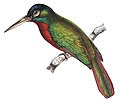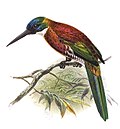Superregnum: Eukaryota
Regnum: Animalia
Subregnum: Eumetazoa
Cladus: Bilateria
Cladus: Nephrozoa
Superphylum: Deuterostomia
Phylum: Chordata
Cladus: Craniata
Subphylum: Vertebrata
Infraphylum: Gnathostomata
Superclassis: Tetrapoda
Cladus: Reptiliomorpha
Cladus: Amniota
Classis: Reptilia
Cladus: Eureptilia
Cladus: Romeriida
Subclassis: Diapsida
Cladus: Sauria
Infraclassis: Archosauromorpha
Cladus: Crurotarsi
Divisio: Archosauria
Subsectio: Ornithodira
Subtaxon: Dinosauromorpha
Cladus: Dinosauria
Ordo: Saurischia
Cladus: Theropoda
Cladus: Neotheropoda
Infraclassis: Aves
Cladus: Euavialae
Cladus: Avebrevicauda
Cladus: Pygostylia
Cladus: Ornithothoraces
Cladus: Euornithes
Cladus: Ornithuromorpha
Cladus: Ornithurae
Cladus: Carinatae
Parvclassis: Neornithes
Cohors: Neognathae
Ordo: Piciformes
Familia: Galbulidae
Genus: Galbula
Species: G. albirostris – G. chalcothorax – G. cyanescens – G. cyanicollis – G. dea – G. galbula – G. leucogastra – G. pastazae – G. ruficauda – G. tombacea
Name
Galbula Brisson, 1760
Typus
Alcedo galbula Linnaeus, 1766 = Galbula galbula
References
Brisson, M.J. 1760. Ornithologie ou méthode contenant la division des oiseaux en ordres, sections, genres, especes & leurs variétés. A laquelle on a joint une description exacte de chaque espece, avec les citations des auteurs qui en ont traité, les noms qu'ils leur ont donnés, ceux que leur ont donnés les différentes nations, & les noms vulgaires. Ouvrage enrichi de figures en taille-douce. Tome I. - pp. j-xxiv [= 1-24], 1-526, j-lxxiij [= 1-73], Pl. I-XXXVII [= 1-37]. Paris. (Bauche). Original description p.42 BHL Reference page. Illustration pl.I, fig.11 BHL Tome 4 p.86 BHL Illustration pl.V, fig.1 BHL
Galbula is the type and largest genus of the jacamar family (Galbulidae) of piciform birds, and its suborder Galbulae. Sometimes, the Piciformes are split in two, with the Galbulae upranked to full order Galbuliformes.[1]
The genus was introduced by the French zoologist Mathurin Jacques Brisson in 1760 with the green-tailed jacamar (Galbula galbula) as the type species.[2][3] The name galbula is the Latin word for a small yellow bird.[4]
They are smallish to mid-sized forest birds of the Neotropics, with long pointed bills, elongated tails, and small feet. Colored in metallic iridescent hues – typically greenish – at least on the upperside, some have a red or brownish belly. Males and females are generally similar in appearance, but in most species differ in minor plumage details. As usual for Piciformes, they nest in burrows they dig out themselves. In the case of this genus, nests are dug in earthen banks along rivers or roads, or in termitaria. As with other jacamars but otherwise unknown among Piciformes, their chicks do not hatch naked. They have a piping song and feed in typical jacamar fashion, by catching flying arthropods, typically larger insects such has butterflies.[1]
Most Galbula species are fairly common in their natural range, which despite rampant deforestation is still extensive. Only the coppery-chested jacamar (G. pastazae) occurs in a more restricted region in the Andes foothills, and is considered a threatened species.[1]
Species
Ten living species are presently recognized in this genus:[5]
| Image | Scientific name | Common Name | Distribution |
|---|---|---|---|
.jpg/120px-Galbula_albirostris_-_Yellow-billed_jacamar_(male).jpg) |
Galbula albirostris | Yellow-billed jacamar | Brazil, Colombia, French Guiana, Guyana, Suriname, and Venezuela |
 |
Galbula cyanicollis | Blue-necked jacamar | Amazon rainforest of Brazil, far northern Bolivia and eastern Peru |
.jpg/120px-Ariramba-de-cauda-ruiva_(cropped).jpg) |
Galbula ruficauda | Rufous-tailed jacamar | southern Mexico, Central America and South America as far south as southern Brazil and Ecuador |
;_Anavilhanas_islands,_Novo_Airão,_Amazonas,_Brazil.jpg/120px-Galbula_galbula_-_Green-tailed_Jacamar_(male);_Anavilhanas_islands,_Novo_Airão,_Amazonas,_Brazil.jpg) Brazil.jpg" decoding="async" srcset="//upload.wikimedia.org/wikipedia/commons/thumb/3/37/Galbula_galbula_-_Green-tailed_Jacamar_%28male%29%3B_Anavilhanas_islands%2C_Novo_Air%C3%A3o%2C_Amazonas%2C_Brazil.jpg/180px-Galbula_galbula_-_Green-tailed_Jacamar_%28male%29%3B_Anavilhanas_islands%2C_Novo_Air%C3%A3o%2C_Amazonas%2C_Brazil.jpg 1.5x, //upload.wikimedia.org/wikipedia/commons/thumb/3/37/Galbula_galbula_-_Green-tailed_Jacamar_%28male%29%3B_Anavilhanas_islands%2C_Novo_Air%C3%A3o%2C_Amazonas%2C_Brazil.jpg/240px-Galbula_galbula_-_Green-tailed_Jacamar_%28male%29%3B_Anavilhanas_islands%2C_Novo_Air%C3%A3o%2C_Amazonas%2C_Brazil.jpg 2x" data-file-width="1964" data-file-height="2232" height="136" width="120" /> Brazil.jpg" decoding="async" srcset="//upload.wikimedia.org/wikipedia/commons/thumb/3/37/Galbula_galbula_-_Green-tailed_Jacamar_%28male%29%3B_Anavilhanas_islands%2C_Novo_Air%C3%A3o%2C_Amazonas%2C_Brazil.jpg/180px-Galbula_galbula_-_Green-tailed_Jacamar_%28male%29%3B_Anavilhanas_islands%2C_Novo_Air%C3%A3o%2C_Amazonas%2C_Brazil.jpg 1.5x, //upload.wikimedia.org/wikipedia/commons/thumb/3/37/Galbula_galbula_-_Green-tailed_Jacamar_%28male%29%3B_Anavilhanas_islands%2C_Novo_Air%C3%A3o%2C_Amazonas%2C_Brazil.jpg/240px-Galbula_galbula_-_Green-tailed_Jacamar_%28male%29%3B_Anavilhanas_islands%2C_Novo_Air%C3%A3o%2C_Amazonas%2C_Brazil.jpg 2x" data-file-width="1964" data-file-height="2232" height="136" width="120" /> |
Galbula galbula | Green-tailed jacamar | Brazil, Colombia, French Guiana, Guyana, Suriname, and Venezuela |
 Ecuador S4E0608.jpg" decoding="async" srcset="//upload.wikimedia.org/wikipedia/commons/thumb/f/f6/Coppery-chested_Jacamar_-_Ecuador_S4E0608.jpg/180px-Coppery-chested_Jacamar_-_Ecuador_S4E0608.jpg 1.5x, //upload.wikimedia.org/wikipedia/commons/thumb/f/f6/Coppery-chested_Jacamar_-_Ecuador_S4E0608.jpg/240px-Coppery-chested_Jacamar_-_Ecuador_S4E0608.jpg 2x" data-file-width="760" data-file-height="1140" height="180" width="120" /> Ecuador S4E0608.jpg" decoding="async" srcset="//upload.wikimedia.org/wikipedia/commons/thumb/f/f6/Coppery-chested_Jacamar_-_Ecuador_S4E0608.jpg/180px-Coppery-chested_Jacamar_-_Ecuador_S4E0608.jpg 1.5x, //upload.wikimedia.org/wikipedia/commons/thumb/f/f6/Coppery-chested_Jacamar_-_Ecuador_S4E0608.jpg/240px-Coppery-chested_Jacamar_-_Ecuador_S4E0608.jpg 2x" data-file-width="760" data-file-height="1140" height="180" width="120" /> |
Galbula pastazae | Coppery-chested jacamar | southern Colombia, Ecuador and far northern Peru |
 |
Galbula cyanescens | Bluish-fronted jacamar | western Amazon Basin of Ecuador, Peru and far northwestern Bolivia. |
 |
Galbula tombacea | White-chinned jacamar | Amazon Basin of Colombia, Amazonas and northern parts of Ecuador and Peru |
 |
Galbula chalcothorax | Purplish jacamar | western Amazon Basin of Ecuador, Peru, southern Colombia and western parts of Acre and Amazonas |
.jpg/120px-Purplish_Jacamar_(Galbula_leucogastra).jpg) |
Galbula leucogastra | Bronzy jacamar | Bolivia, Brazil, Colombia, French Guiana, Guyana, Suriname, and Venezuela |
 |
Galbula dea | Paradise jacamar | Bolivia, Brazil, Colombia, Ecuador, Peru and the Guyanas |
A fossil species, Galbula hylochoreutes, has been described from the mid-Miocene of Colombia. It was apparently more specialized for aerial feeding than the living species.
References
Tobias, J.; Züchner T. & T.A. de Melo Júnior (2002) "Family Galbulidae (Jacamars)". in del Hoyo, J.; Elliot, A. & Sargatal, J. (editors). (2002). Handbook of the Birds of the World. Volume 7: Jacamars to Woodpeckers. Lynx Edicions. ISBN 84-87334-37-7
Brisson, Mathurin Jacques (1760). Ornithologie, ou, Méthode Contenant la Division des Oiseaux en Ordres, Sections, Genres, Especes & leurs Variétés (in French and Latin). Paris: Jean-Baptiste Bauche. Vol. 1, p. 42, Vol. 4, p. 86.
Peters, James Lee, ed. (1948). Check-list of Birds of the World. Volume 6. Cambridge, Massachusetts: Harvard University Press. p. 5.
Jobling, J.A. (2019). del Hoyo, J.; Elliott, A.; Sargatal, J.; Christie, D.A.; de Juana, E. (eds.). "Key to Scientific Names in Ornithology". Handbook of the Birds of the World Alive. Lynx Edicions. Retrieved 2 April 2019.
Gill, Frank; Donsker, David, eds. (2019). "Jacamars, puffbirds, toucans, barbets, honeyguides". World Bird List Version 9.1. International Ornithologists' Union. Retrieved 2 April 2019.
Retrieved from "http://en.wikipedia.org/"
All text is available under the terms of the GNU Free Documentation License

